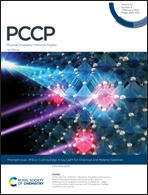The regulation mechanism of phosphorylation and mutations in intrinsically disordered protein 4E-BP2†
Abstract
Eukaryotic translation initiation factor 4E binding protein 2 (4E-BP2) is an inhibitor of mRNA cap-dependent translations. Wild-type (WT) 4E-BP2 is intrinsically disordered under physiological conditions, while phosphorylation converts the disordered fragments 18–62 into a four-stranded β-sheet structure. The regulation mechanism of phosphorylation on 4E-BP2 still remains ambiguous. In this study, replica-exchange molecular dynamics (REMD) simulations were utilized to sample the conformation spaces of WT, phosphorylated WT (pWT), and phosphorylated mutated (pMT) 4E-BP2. Starting from extended structures, the folded structures were only observed in pWT simulations. The folding pathway shows that the folded structures of pWT are formed in the order of β1/β4, β3, and β2. The formation of β-turns on pWT, which are driven by hydrogen bonds between the phosphorylated residues and adjacent residues, are the rate-limiting steps in the folding process. The long-range electrostatic interactions contribute toward the stabilization of the folded structures. Moreover, the disruption of β-turn structures induced by mutations would prevent the folding of pMT 4E-BP2. Our finding is helpful in understanding the regulation of the structural ensembles of intrinsically disordered proteins.



 Please wait while we load your content...
Please wait while we load your content...